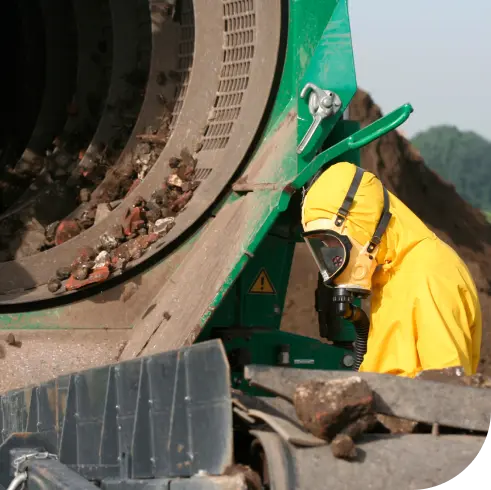Biphasic Mesothelioma
Biphasic mesothelioma is a cell type of mesothelioma characterized by a combination of sarcomatoid and epithelial cancer cells. The prognosis and treatment options for patients with this cell type vary based on the ratio of sarcomatoid cells to epithelial cells, with a better prognosis for patients with higher ratios of epithelial cells.
Home » National Mesothelioma Law Firm » Mesothelioma Cancer » Mesothelioma Cell Types » Biphasic Mesothelioma
Mesothelioma is a cancer of the membrane surrounding the lungs, abdominal organs, heart, or testicles. Besides the location where it develops, this cancer can be further categorized by the specific type of cancer cells that develop. The three main mesothelioma cell types are sarcomatoid, epithelioid, and biphasic.
In approximately 20 percent of mesothelioma cases, both sarcomatoid and epithelioid cells are present. This is generally called biphasic mesothelioma but can also be known as mixed mesothelioma. For mesothelioma to be classified as biphasic, there must be a minimum of 10 percent each of sarcomatoid and epithelioid cells within the tumor.
Characteristics of the Mesothelioma
Cell Types
The course of biphasic mesothelioma may vary based on the proportion of the two cell types. For example, if more epithelioid cells are present, the disease will more closely resemble epithelioid mesothelioma. If more sarcomatoid cells are present, the disease will more closely resemble sarcomatoid mesothelioma.
Sarcomatoid Mesothelioma
Sarcomatoid mesothelioma consists of cancer cells that are spindle-like and non-cohesive. Sarcomatoid cancer cells tend to break apart from each other and spread to distant areas of the body. This tendency to break apart makes patients with this cell type poor candidates for surgery, as the tumor can break apart during removal and is likely to have already spread (even microscopically) before surgery.
Sarcomatoid mesothelioma is the least responsive to treatment and has the poorest prognosis, with a median overall survival of 3.5 to 8 months. Fortunately, it is the rarest form of mesothelioma, occurring in about 10 percent of all mesothelioma cases, according to the Journal of Thoracic Disease.
The characteristics of sarcomatoid cells may vary, and this can impact the prognosis. Common sarcomatoid cell variants include desmoplastic, lymphohistiocytoid, and heterologous subtypes. Desmoplastic mesothelioma is associated with a poorer prognosis, and lymphohistiocytoid is associated with a longer overall survival.
Treatment options for sarcomatoid mesothelioma are limited. In addition to being unresectable (meaning that surgery is not a good treatment option), sarcomatoid cells are often resistant to systemic treatments such as chemotherapy. However, clinical trials of chemotherapy combined with immunotherapy are yielding promising results.
Epithelioid Mesothelioma
Epithelioid mesothelioma consists of cancer cells that are polygonal or round and cohesive in nature. Epithelioid cancer cells multiply quickly, resulting in the relatively fast growth of tumors. However, due to their cohesive nature, this cell type does not spread to other parts of the body as quickly as the sarcomatoid type.
Epithelioid mesothelioma is the most common form of mesothelioma, accounting for approximately 60 percent of all mesothelioma cases. This cell type is generally more responsive to treatment than biphasic or sarcomatoid mesothelioma, and patients with this cell type have more treatment options that may include the following:
- Surgery
- Chemotherapy
- Immunotherapy
- Radiotherapy
- Multimodal therapy (involves a combination of treatment types)
Patients with this cell type generally have a longer life expectancy, with a median overall survival of 14.4 months. However, the prognosis varies from patient to patient based on individual factors, including the specific characteristics of the epithelioid cancer cells, which may be classified into subtypes such as the following:
- Well-differentiated papillary mesothelioma (WDPM)
- Solid
- Tubulopapillary
- Micropapillary
- Adenomatoid
- Pleomorphic
- Myxoid
- Deciduoid
How common is biphasic mesothelioma?
Mesothelioma, in general, is a rare cancer with approximately 3,000 new diagnoses per year in the United States. According to the Centers for Disease Control and Prevention, more than 1.75 million cancer diagnoses occurred in 2019, indicating that mesothelioma accounts for just 0.17 percent of all cancer diagnoses in the United States.
Biphasic mesothelioma is also relatively rare compared with all mesothelioma cases. It accounts for approximately 20 percent of pleural mesothelioma cases and, according to Cureus, 25 percent of peritoneal mesothelioma cases.
Biphasic Mesothelioma Symptoms
Biphasic mesothelioma is often asymptomatic until the disease has progressed to a late stage. When symptoms do emerge, they are non-specific and mimic several conditions that are more common and less specific.
Biphasic Pleural Mesothelioma
Like other types of pleural mesothelioma, biphasic pleural mesothelioma may present with the following symptoms:
- Shortness of breath
- Chest pain
- Dry cough
- Hoarseness
- Weight loss
- Loss of appetite
- Night sweats
- Fever
A chest X-ray may reveal pleural effusion or thickening of the pleura. The pleura is the lining around the lungs. A pleural effusion is a build-up of fluid in the space between the two layers of the pleura.
Biphasic Peritoneal Mesothelioma
Like other types of peritoneal mesothelioma, the symptoms of biphasic peritoneal mesothelioma may include the following, according to Cureus:
- Abdominal pain
- Distension with ascites (fluid buildup inside the stomach)
- Intestinal obstruction
- Tendency to form blood clots
- Fever
- Weight loss
- Loss of appetite
- Fatigue
- Nausea and vomiting

Diagnosing Biphasic
Mesothelioma
Mesothelioma in any form can be difficult to diagnose because the symptoms are similar to those of multiple other conditions that are more common and less serious. As a result, diagnosis is often delayed, and this may worsen the prognosis.
Biphasic mesothelioma often mimics the following conditions, according to Case Reports in Pulmonology:
- Lymphoma
- Plasma cell neoplasm
- Ewing’s sarcoma

Diagnostic Tests
Diagnosing biphasic mesothelioma requires a series of tests that include a combination of imaging and cytology. Diagnostic tests typically include a combination of the following:
- Chest X-rays to identify issues such as pleural effusions and also rule out other diseases like pneumonia
- CT scans to provide a detailed image of the tumor
- A biopsy for laboratory testing
- Magnetic resonance imaging (MRI) to localize the tumor and identify additional tumors
- PET scans to identify malignant cells and check for metastasis, the spread of tumors to the lymph nodes and other parts of the body
Biphasic Mesothelioma Prognosis
The median overall survival for biphasic mesothelioma is 9.5 months, but this can vary based on the proportion of epithelioid cells compared to sarcomatoid. The overall median survival for patients with the sarcomatoid and epithelioid types is 5.3 months and 14.4 months, respectively, and the median survival for biphasic mesothelioma falls between these values.
A study published in Translational Lung Cancer Research found that patients whose biphasic tumors were made up of more than 50 percent epithelioid cells had markedly improved overall survival compared with patients whose tumors were more than 50 percent sarcomatoid cells.
A French study found that epithelioid involvement of at least 20 percent predicted better overall survival.
What causes biphasic mesothelioma?
Biphasic mesothelioma is almost always caused by exposure to asbestos. Asbestos was considered a miracle mineral during the peak of the Industrial Revolution, resulting in widespread occupational exposure as well as exposure to products that contained asbestos in homes and public buildings. It was also widely used in the military, particularly by the Navy.
When asbestos is disturbed, the microscopic fibers become airborne, which allows them to be inhaled or ingested. These fibers embed in the body’s tissues and cannot be broken down, leading to a sustained inflammatory response. Over a period of decades, this inflammation causes cell damage that ultimately leads to asbestos-related diseases, including biphasic mesothelioma.

Treatment for Biphasic Mesothelioma
Treatment options for biphasic mesothelioma vary based on what percentage of the cancer cells are of the epithelioid or sarcomatoid type. If there’s a significant proportion of sarcomatoid cells, then treatment options may be limited, as these cells tend to resist treatment and are considered to be inoperable. However, some practitioners may offer surgical options if the proportion of epithelioid cells is high enough.

Chemotherapy
When treating biphasic mesothelioma with the same methods they would use to treat sarcomatoid mesothelioma, health care providers turn to systemic chemotherapy as the mainstay of treatment. Chemotherapy usually involves a combination of pemetrexed and either cisplatin or carboplatin. Chemotherapy may be combined with immunotherapy, which has shown positive results in studies.

Radiation Therapy
Radiation therapy uses high-energy X-rays or particles to kill cancer cells and shrink tumors. While chemotherapy is considered a systemic treatment, radiation therapy is local. It is often used in conjunction with chemotherapy or surgery.

Multimodal Therapy
Multimodal therapy uses a combination of treatment modalities to treat mesothelioma. Multimodal therapy, especially when it involves surgery, is controversial in biphasic mesothelioma cases due to the sarcomatoid component.
A study published in the Journal of Thoracic and Cardiovascular Surgery found that multimodal approaches that include surgery are beneficial in select cases of biphasic mesothelioma.

Tumor-Treating Fields (TTFields)
Tumor-treating fields (TTFields) are a newer treatment option that has shown promising results for treating cases of unresectable mesothelioma, meaning that the tumor cannot be removed surgically. TTFields use low-intensity electrical currents targeted at tumors through the skin.
The FDA has approved TTFields for treating patients with unresectable pleural mesothelioma, including many patients with biphasic tumors. The device is often used along with chemotherapy.

Comfort Measures
Biphasic mesothelioma symptoms and treatment side effects can impair quality of life if not managed. Many mesothelioma treatment centers provide a whole-patient approach that strongly emphasizes palliative care, which focuses on the physical, emotional, mental and spiritual health of the patient. This can be used alongside treatments intended to extend life.
Palliative treatment options may include medications, procedures, and even surgery aimed at increasing the patient’s comfort.
Alternative Medicine Approaches
While alternative medicine has not been shown to extend life for mesothelioma patients, it has been shown to be effective in managing symptoms and improving a patient’s well-being. If you are considering using alternative approaches, it is best to discuss this with your doctor ahead of time. Some options include meditation, acupuncture, and yoga.
Where to Seek Biphasic Mesothelioma Treatment
When seeking treatment for biphasic mesothelioma, it is important to consult with doctors who specialize in mesothelioma. Because mesothelioma is rare, it’s unlikely that doctors who do not specialize in mesothelioma will have the experience necessary to diagnose and treat the condition.
Mesothelioma doctors practice all across the United States.
To access the most advanced treatment options available, look for mesothelioma specialists who:
- Participate in clinical trials with leading investigative roles
- Use a personalized approach
- Belong to a comprehensive treatment center with a whole-patient approach
- Offer novel therapies
- Are involved in mesothelioma advocacy organizations
- Actively participate in mesothelioma research
- Hold leadership positions in mesothelioma programs
- Publish papers about mesothelioma
- Leverage multimodal therapy
By submitting this form, you agree to our terms & conditions. Please read the full disclaimer



